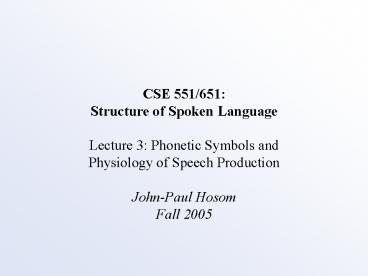CSE 551651: - PowerPoint PPT Presentation
1 / 23
Title: CSE 551651:
1
CSE 551/651 Structure of Spoken
Language Lecture 3 Phonetic Symbols
andPhysiology of Speech Production John-Paul
Hosom Fall 2005
2
More Formant Data
(source unknown)
3
Effects of Coarticulation
4
Phonetic Symbols the IPA The International
Phonetic Alphabet (IPA) (reproduced compliments
of the International Phonetic Association,
Department of Linguistics, University of
Victoria, Victoria, British Columbia, Canada)
5
Phonetic Symbols the IPA
6
Phonetic Symbols the IPA
Produced With tip of tongue, e.g. Spanish /r/
Tongue tip or blade touching upper lip
7
Phonetic Symbols the IPA Other IPA symbols
8
Phonetic Symbols the IPA Examples
9
Phonetic Symbols Worldbet An ASCII
representation of IPA, developed by Hieronymous
(ATT)
10
Phonetic Symbols ARPAbet, TIMITbet, OGIbet
ASCII representation of English used in TIMIT
corpus.
11
Phonetic Symbols SAMPA An ASCII representation
for multiple (European) languages
12
Acoustic Phonetics Anatomy
nasal tract
(hard) palate
velic port
oral tract
alveolar ridge
velum (soft palate)
lips
tongue
teeth
pharynx
glottis
tongue tip
vocal cords (larynx)
The Speech Production Apparatus (from Olive, p.
23)
13
- Acoustic Phonetics Anatomy
- Breathing and Speech (from Daniloff, chapter 5)
- Duration of expiration in soft speech is 2.4 to
3.5 seconds maximum value (singers, orators)
is 15 to 20 seconds without distress. - Louder voice requires inhaling more deeply after
expiration also deeper inhalation if
followed by longer speech. - More intense voicing requires greater lung
pressure. - Lung pressure relatively constant throughout an
utterance. - Emphasis in speech greater tenseness in vocal
folds yielding higher F0 greater lung
pressure increases airflow (energy).
14
Acoustic Phonetics Anatomy
the false vocal folds narrow the glottis during
swallowing, preventing pieces of food from
getting into the trachea.
15
Acoustic Phonetics Anatomy Phonation (from
Daniloff, chapter 6) Phonation is conversion
of potential energy of compressed air into
kinetic energy of acoustic vibration. For
voiced speech 1. Buildup of Pressure air
pressure from the lungs pushes against closed
vocal folds so that Psubglottal gt Poral buildup
continues until until Psubglottal Poral gt
elastic recoil force of vocal folds 2.
Release vocal folds forced open by pressure
difference burst of compressed air hits air in
vocal tract, causing acoustic shock wave moving
along vocal tract
16
Acoustic Phonetics Anatomy Phonation 3.
Closure of Vocal Folds, two factors (a) force
of elastic recoil in vocal folds Vocal
folds have elastic or recoil force proportional
to the degree of change from the resting
position. (b) Bernoulli Effect (i) energy
at location of vocal folds is conserved
E KE PE (iii) increase in KE causes
decrease in PE (iv) PE corresponds to
pressure of air (v) drop in pressure
causes walls of glottis to be drawn closer
together Summary air burst causes high
rate of airflow, causes drop in pressure,
causes folds to be pulled together
17
- Acoustic Phonetics Anatomy
- Implications
- vocal folds do not open and close because of
separate muscle - movements
- 2. opening and closing is automatic as long as
the resting position - of the vocal folds is (near) closure, and there
is sufficient - pressure buildup below vocal folds
- 3. Factors governing vocal fold vibration
- (a) position of vocal folds (degree of closeness
between folds) - (b) elasticity of vocal folds, depending on
position and - degree of tension
- (c) degree of pressure drop across vocal folds
18
Acoustic Phonetics Anatomy Types of phonation
(from Daniloff, p. 194)
quiet breathing
forced inhalation
normal phonation
whisper
19
Acoustic Phonetics Anatomy The cycle of
glottal vibration (from Daniloff, p. 171)
1. folds at rest
2. muscle contraction
5. explosion open
6. acoustic shockwave
3. increase in pressure
4. forcing folds apart
8. folds close, goto step (3)
7. rebound toward closure
20
Acoustic Phonetics Anatomy The cycle of
glottal vibration (from Pickett, p. 50)
opening to closure, 2.4 to 4.5 msec
closure to opening, 0 to 2.1 msec
(F0 222 Hz)
21
Acoustic Phonetics Anatomy Types of phonation
(from Daniloff, p. 174)
voiced, creak, glottal stop
voiceless, whisper, breathy
22
Acoustic Phonetics Anatomy The effects of
nasalization on vowels (from Pickett, p. 71)
Figure 4-17. An example of the effects of vowel
nasalization on the vowel spectrum. The
spectrum envelopes of a normal a and a
heavily nasalized a were plotted The
first three formants are labeled in the normal
vowel. In the nasalized vowel, there are three
local reductions in spectrum level, indicated by
zs these are the result of the addition of
anti-resonant zeros to the vocal tract response,
due to a wide-open velar port.
23
- Acoustic Phonetics Anatomy
- The effects of nasalization on vowels (from
Pickett, p. 71) - Coupling of the oral and nasal tract introduces
pole-zero pairs - (resonances anti-resonances, occurring in
pairs) in the spectrum. - The amount of coupling affects the spacing
between each pole - and its corresponding zero, as well as their
frequency locations. - The presence of a pole-zero pair increases the
apparent bandwidth of the neighboring formants. - The presence of spectral zero below F1 tends to
make the location of F1 appear slightly higher
(50-100 Hz) than it normally would - If the zero is higher in frequency than its
corresponding pole, the net effect is to reduce
the amplitude of higher frequencies

